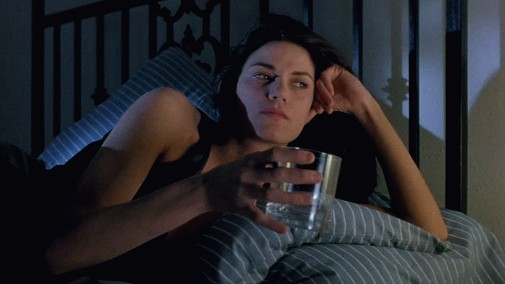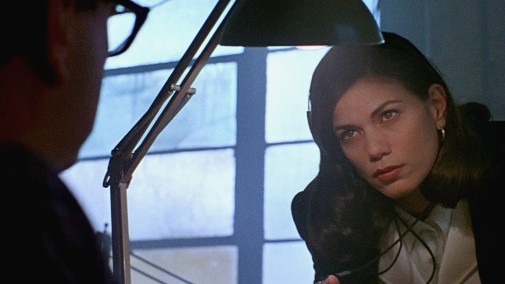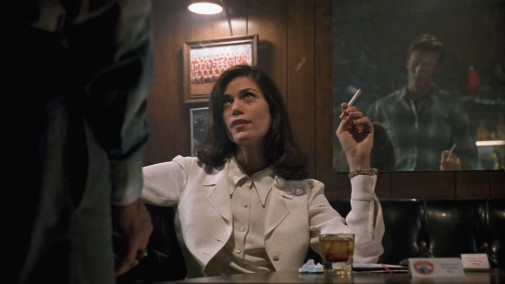
Since last month, the Criterion Channel is offering a collection of neo-noirs, modern films from the 70s onwards that perpetuate the tradition of 1940s and 50s crime pictures. Freer to explore matters of sex and violence, these versions of film noir tend to be more visceral, updating old archetypes into vicious evocations of misanthropic cinema. For actressexuals, the evolution of the femme fatale is especially enticing. From Kathleen Turner's oversexed take on a Phyllis Dietrichson type in Body Heat to Nora Zehetner's mysterious high-schooler in Brick, this immortal character has gone through an infinite myriad of transfigurations. Maybe none of them caused as much hubbub during her awards season as Linda Fiorentino in John Dahl's The Last Seduction…

We hear her before we see her, a contemptuous voice spitting abuse at a measured pace. Her targets are male subordinates, sweaty, desperate fellows trying to make a sale while she puts pressure on them. It's a marvelous opening, finally punctuated by Fiorentino's face. Appearing on-screen at long last, sleek-haired and red-lipped, she's an obstinate seductress of classic noir displaced in a 1990s erotic thriller. Bridget Gregory is a telemarketing manager living in New York City with her husband Clay. He's a drug-dealing loser who needs money fast to pay a loan shark. As soon as he's acquired $700,000, Bridget absconds with the loot. On her way to Chicago, she stops in a small town, Beston, and ends up forging a fake identity, finding a job and a fuckboy for her pleasure.
One of The Last Seduction mysteries is how much of Bridget's plan is premeditated and how much is a spur-of-the-moment scheme. She's adept at thinking on her feet, weaseling her way out of tricky situations by weaponizing sexuality and manipulating simple-minded men. However, throughout the story, the motive for this woman's life-changing evasion is continuously traced back to when Clay turned violent in reaction to one of Bridget's insults. He hits her, she acts shocked and hurt, but the surprise quickly melts into performative quiet. Fiorentino keeps us at a distance, letting us guess how much the domestic altercation's indignancy shook the character. In any case, her following actions are swift, oriented around a straightforward impulse – get the money and run.

The sight of Clay's little fortune, its touch, and tangible promise make her shift gears. It's difficult to parse out what actions are organic and what behaviors are calculated measures, but there's genuine wantonness in how Bridget relates to hard cash. She licks the bills for Clay's horny amusement, but her relationship with the dough is more serene, reverent, and ecstatic when alone. She smells it, intoxicated in a moment of intimate pause that's only for us, the camera and the audience. There's no similar instant for contemplation in the ensuing narrative, seeing as Bridget is constantly on the alert, seducing and tricking, lying and setting the pieces on her mental chessboard that will result in a most astonishing checkmate. For her part, Fiorentino is brilliant at this kind of opaque character construction.

That's partially what attracts every man in the film to her Bridget. She feels superior and impenetrable, a challenging impossibility that harkens back to how audiences once upon a time regarded bigger-than-life movie stars. She's out of this world, but instead of alienation, this personal quality produces intractable attraction. Consider the seduction of her Bestonite lover, Mike Swale. Cocksure and touched by a hint of self-aggrandizing intoxication, he's ready to try his tricks on a beautiful stranger from out of town. Before he knows it, the power dynamics of the interaction have been rudely switched around, with her taking control. The way she does it is practiced, effortless, with a touch of blunt aggression and a direct stare. She tosses off her commands in a husky voice, molded by many cigarettes and whiskeys, aloof but never completely uninvested.

If he's hung like a horse, why doesn't he show his dick to her? She's not a girl who's likely to purchase something without seeing it first. Cupping Mike's junk to make sure he's as gifted as he promised, smelling her fingers, and smirking disaffectedly at her bemused bar mate, Bridget looks like a cat playing with a rat. She's a growly predator who enjoys nibbling at her prey, finding pleasure in the squirms, the shock. Moreover, the femme fatale never hides her contempt for the lesser creatures at her feet, letting them bask in the hateful gaze and become all the more eager to get a sign of unachievable approval. All that, and there's the way she moves. Fiorentino embodies a physical demeanor characterized by so great a confidence that it's difficult to regard Bridget as a sexual object. Of course, she invites such readings to dominate the prey better, but there's complicated strength to the on-screen presentation.

Underestimate her - objectify her - at your own risk. That's the great lesson of The Last Seduction, a film that's as in love with the abject amorality of its lead character as any film can be. The truth is that for as nasty as Fiorentino's Bridget is, one cannot ignore her nor defend oneself against her magnetic pull. You see, The Last Seduction is a nasty film, so its relationship to the anti-heroine is more akin to devotion than revulsion. We're not meant to balk at Bridget's villainy but to love her for it. What's more, this is not something that happens around the performer, for Fiorentino is clearly in the know regarding Bridget's silver screen power. The actress was the one who came up with such beats of ill-intent as the putting out of a cigarette in a grandma's homemade pie. That also manifests in how she plays the femme fatale's more overt manipulations.
Seeing her put on a benign mask during a job interview, phoning a wronged wife, or giving the police a false testimony, is a spectacular performance within a performance. It's especially beguiling when Fiorentino does it with a knowing audience, like Mike, nearby. She's having devilish fun playing with people while also putting on a show. It's dangerous, revealing her game so openly. In the end, though, it's all part of the bigger picture, creating a sense of false intimacy. Within the universe of The Last Seduction, Fiorentino's Bridget is both actress, writer, and director, a criminal artist using her wits so that people do everything she wants. Illustrating all this and making it fun, making it perceptible for the viewer, just complicated enough so that she's always two steps ahead, is an astounding accomplishment. It's the type of mastery that puts Linda Fiorentino in the pantheon of the greatest femme fatales in film history.

Now, one can't talk about Fiorentino's performance in the context of Oscar without mentioning that she was never eligible for the award. As in 1974 with Liv Ullmann, the porous membrane separating TV and cinema became a central issue in the actress's pursuit of industry awards. Let's make one thing clear, The Last Seduction was made for cinemas. The picture went through the festival circuit searching for distribution, even getting a screening at the Berlinale. Unfortunately, it was difficult for the movie's producers to get theatrical distribution, and, seeing an opportunity, they allowed it to be shown one July night on HBO. That ended up being a fatal mistake. Once The Last Seduction got a theatrical run later in 1994, critics went wild for it and soon started talking about Fiorentino as the Best Actress of the cinematic year.
Unfortunately, that HBO showing made the movie ineligible for Oscars. Outraged, many critics rallied around Linda Fiorentino, with such big names as Roger Ebert openly condemning AMPAS' ruling. At a certain point, the makers of The Last Seduction even tried to sue the Academy, though they dropped the case soon enough. Nevertheless, Fiorentino was nominated for a BAFTA, numerous critics prizes, and she won a couple of big ones like the NSFC and NYFCC awards for Best Actress. The famously "weak" Oscar lineup comprised Jodie Foster in Nell, Jessica Lange in Blue Sky, Miranda Richardson in Tom & Viv, Winona Ryder in Little Women, and Susan Sarandon in The Client. Lange ended up winning for a film that waited years for a release after its studio's bankruptcy. Fiorentino is better than all of them in my book, delivering a genre performance for the ages.

The Last Seduction is streaming on the Criterion Channel, Hoopla, and Tubi. You can also rent it on other platforms.